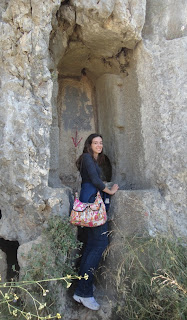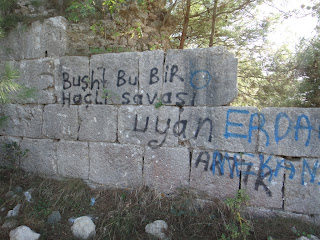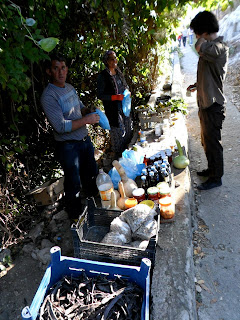(Warning--this one is picture and information overload. Sorry...or you're welcome)
Each semester the RCAC provides two field trips, both of which are nominated and voted on by the fellows. The institute covers travel costs, hotels, and most meals (and we eat very well). For our first field trip, we ventured down south to Antakya (Ancient Antioch). What did I do? In short, I climbed mountains, swam in the Mediterranean, bought scarves, soap, and illegal fig wine, saw three churches, a synagogue, and multiple mosques, walked in the steps of the Hittites, Romans, persecuted Christians, Paul (from the Bible), Crusaders, and Templar Knights, studied mosaics, ate never-ending meals, smoked hookah at Asia, and befriended a puppy. It was a great trip. For more details read on.
Early Iron Age column base
Roman Sarcophagus
Aleksander acting the part of the persecuted, escaping up a tunnel as he is pursued by the Romans (played by me!)
Mosaics!
OMG--so good!
My future puppy
Antakya: The city is the seat of government for the Hatay region of Turkey, which is just north of the Syrian border. The city is perhaps better known to westerners as Antioch, the place where the followers of Jesus were first called Christians. Mountains seem to almost encircle the city, but it does open out unto the fertile Amuq Plain. The Orontes River runs through the urban center and out to the Mediterranean (22km). The city was founded by Seleucus I Nicator (a successor of Alexander the Great) in 300 BCE and became one of the largest cities in the Roman and Byzantine Empires; it saw multiple attacks and sieges during the course of the first few crusades and eventually lost its economic and political importance in the 13th century, when activity moved to the port city of Iskenderum, ancient Alexandretta (that’s Indian Jones reference 1, for those counting!).
Today, the city is considered fairly cosmopolitan with numerous people having moved here, especially from Syria (in fact, many of the refugees are living in tent communities in the Amuq plain and elsewhere). It is known as a city of religious tolerance (we visited a number of different religious buildings). Antakya is a great place to buy olive soap, pomegranate molasses, silk scarves, and fig wine (which turns out is illegal, homemade, and can easily be switched with bad raki without the knowledge of unsuspecting Americans). The streets are filled with tea houses, cafes, and restaurants, which is great because the food here is amazing. Especially famous is the kunefe (a hot-cheese, pastry dessert), but also the pumpkin and walnut desserts, the amazing hummus, and the great kebabs.
South Korean Evangelican Christian Church
Greek Orthodox
Synagogue
One of many mosques
Catholic church (just in case you can't read Turkish)
Hummus
Kunefe--cheese dessert
We left for Antakya at the exciting time of 4:30 am on a Friday, to Istanbul airport and then a quick arrival at the tiny regional airport in Hatay. We dropped our stuff off at the glamorous mosaic hotel (I say with a smile), which had somewhat suffocating wall paper, very “classy” mosaic decoration, a dining room that looked like it had been decorated for a wedding, and a series of random things being sold in the hallways and offices (shoes, soap, ties). Off to the museum! The Antakya Archaeological Museum houses the immense collection of mosaics found from the city and its environs, especially the aristocratic suburb of Daphne. These mosaics date from the 2nd-5th centuries CE and take up room after room. Their preservation is incredible; it is discouraging that they are presented in such conditions, however, especially given how rare it is to find such mosaics. But their plight is another story. The museum also houses the numerous finds from the Bronze Age and Iron Age excavations in the area, as well as small finds and coins—these last two with almost no labels or information provided (and at times the wrong information)!
Classy hotel
Unfinished lid of Roman Sarcophagus
Room of mosaics
Room of small finds
not-well-labeled finds
Neo-Hittite lion--our very Lynn Welton found this guy this summer
Storage?
Orange tree in museum garden. We talked the guard into picking us a few.
Off to the Church of St. Peter—a cave church in the mountains overlooking the city [as a brief note, a reoccurring theme in my narrative and photos will probably be the amazing views in Antakya; everywhere we went was breathtaking, whether atop a mountain, standing at the sea, or maneuvering through tunnels—the Hatay region is truly a “Wow” visual experience]. Back to the church—it was carved into the mountain and was apparently where Peter came and preached the gospel (I’m not going to get into the dating problems with this). There are some fresco and mosaic remains from the 5th century, evidence of tunnels, which might have been used as escape options during persecution, and many later additions (including the façade and altar). The church itself is surrounded by rock cut tombs, dating at least into the Hellenistic period; these include tunnels—fun to crawl through—and a creepy/intriguing carving of a large head and figure that we still have no clue about (anyone? Anyone?).
Facade of St. Peter
Learning
Then I got distracted by site cats and kittens
Inside of church
Creepy rock cut carving
Livia going into one of the tombs
To the Citadel! Drive up a mountain, stop at amazing Roman walls with Bush political graffiti, and then the hike begins. We were traipsing! This was the moment that I realized how much I missed surveying—I love hiking! Especially, hiking knowing that old stuff is around. This past summer was the first one in 5 years that I hadn’t worked on an archaeological project—and hiking around the mountain top (and all the other visits to sites we did on the trip) made me realize how much I really missed being in the field. Oh well—next summer, it will be non-stop archaeology adventures! Back to the citadel, a 20 minute hike through the forest, past a possible 6th century open air cistern, and unto the fallen remains of broken walls, collapsed arches, and beautiful views. The citadel, most of the architecture dating to the 10th century, overlooks Antioch (in the most spectacular way). It served as the stronghold besieged during the first crusade (1098)—which was recreated by puppets in a great film I saw at the Istanbul Bienali (see previous entry).
Saturday. Going way back in time with a tour of the Bronze and Iron Age sites of Tell Atchana (Alalakh) and Tell Tayinat (Kunulua) in the Amuq Plain. The ‘sister’ sites were occupied intermittently (and in a roughly complimentary sequence) from the early Bronze Age to the end of the Iron Age and beyond; they sit about 800m apart and were both excavated in the 1930s (by Sir Leonard Wooley and U Chicago, respectively) and again with continuing excavations beginning in the 2000s (by Mustafa Kemal University in Antakya and UToronto, respectively). Tell Atchana was occupied in the Middle and Late Bronze Ages (ca. 2200-1200 BCE) and the remains include architecture (mud brick!!!) of houses, temples, gates, and more. Perhaps the most impressive find, however, was that of the archive—a room filled with hundreds of clay tablets inscribed with Akkadian, Sumerian, and Hurrian. Across the road, amidst a Turkish cotton plantation complete with the cutest guard puppy that ever existed, sits the site of Tell-Tayinat and RCAC’s very own Lynn Welton, who was gracious enough to give us a tour of both sites! Tell-Tayinat has an Early Bronze level (3000-2000BCE) and then a major settlement in the Early Bronze Age and beyond (ca. 1200-550 BCE). The site served as the capital, Kunulua, or the regional Neo-Hittite kingdom, Patina. The remains include an impressive temple complex, inscribed tablets, and huge sculptures (Lynn found the lion this summer!). From here, we went to the dig house for tea, fruit, and crackers. Here we met the grown up version of the site puppy. A brief aside, I am convinced that this is the dog I want—the Kangal, a Turkish sheep dog. They are so amazing—beautiful and intelligent and very sweet. I just hope I can get one small enough to fit in my carry on J
Dig house of Wooley at Tell-Atchana
Some deep trenches!
Mud Brick!
Learning with Lynn!
Tell-Tayinat
Where the lion came from
My future dog!
the cotton fields of southern Turkey
Back in the bus. Food. And we’re off to a new place and time—up more winding mountains and around a bend to Bakras Castle. The ruins of this monument sit on a rocky outcropping over a modern village at the break in a mountain pass between Cilicia and Antioch down to Syria. It protects the Belen Passage (Syrian Gates). Some sort of fortification was here since at least the 1st century BCE, since it is mentioned by Strabo. It was occupied and reoccupied over the centuries, suffered earthquake damage, siege, and massacres. It’s architecture is difficult to date and it’s multiple levels that wind around the hill top make it difficult to understand as a functioning building, but the views are amazing J And it was once (or twice) occupied and owned by the Knights Templar (Indiana Jones reference 2!). The best guess is that the majority of the visible remains date to sometime in the 12th century. Either way, it’s an incredible site to wander around and to take photographs from.
That night, I talked a few fellows into a night out. First stop, the lounge ASIA, with its rooftop terrace, perfect for smoking hookah and having drinks. Unfortunately, the weather was quite a bit chilly, especially on the roof. The fellows all snuggled together (4 to a couch only slightly bigger than a loveseat). A brief stop at another pub to see an awesome and rockin’ Turkish cover band and then we called it a night.
Liverburger...so disappointing, but not because it was bad liver
creepy child mannequin--a required accessory to any Turkish city
Sunday. To the mountains again! Even more mountain-winding, up to the carved out monastery of St. Symeon the Younger, a saint from the 6th century CE. Symeon was an ascetic who lived his life as a pillar hermit—yup, he lived on top of a stone column (think ancient flag pole sitter—for you Harvey Danger fans). At the top of this mountain the carved out a column and a stone staircase where pilgrims could ascend in order to receive his blessing or hear his teaching. Surrounding this column is a complex of churches, halls, a baptistery, and other religious installations—all carved out of the mountain. But can you guess what the most impressive part was? Yes, it was the view! Amazing—with Antioch on one side and the Mediterranean on the other, lines of huge wind turbines towering above and falling away below into the rolling green of forested hills and finally into the red-roofed villages and winding river. I sat atop the wall of one of the halls and toasted the beauty with a drink of fig wine J
A depiction of St. Symeon on his pillar.
The remains of the pillar
Overview
The Mediterranean below
To the beach. Samandağ, the modern town at water’s edge is home to great seafood and fabulous silk scarves (I went a little overboard). It also has a beach on the Mediterranean—with a quick to shorts, I waded in! Lunch. Seleucia Pieria. This ancient city was founded by Seleucus I Nicator in 300 BCE and served as the commercial and military port for the area. It later housed the Roman imperial fleet. Paul departed from here with Barnabus for missionary journeys. Today the site is reached through a series of paths along the hillside that cut along and through people’s gardens, orchards, bee farms and more. Throughout the site, locals are selling their home grown fruit and homemade honey—it was amazing (but I did not bring money, alas). The hills are dotted with rock cut tombs—and one major funerary cave installation. The most impressive (and accessible with a flashlight, but recommended with a headlamp!) part of the site was the tunnel of Titus and Vespasian. As we learned multiple times on our trip, this area is a fluvially-dynamic region with frequent silting of harbors and changing courses of rivers. In order to prevent the silting of the harbor for Seleucia a deep and long water channel was cut to divert the water north of the city. This task was undertaken by Titus in 70 CE, but was not completed until the reign of Antoninus Pius (138-161). The 1400m tunnel/crevasse is channeled through steep stone walls, part of which you can walk/stumble/blindly adventure through today.
The beach at Samandag
Enjoying the view--Thank you Frouke for photos since my camera died!
Seleucia is somewhere in these hills
Cave tomb!
The tunnel
We made many Indiana Jones references in this tunnel (and I basically saved everyone's life with my head lamp!) [slight exaggeration]
Sidewalk seller pedlling their organic, hippie/gypsy deliciousness
reading an inscription!
The beach at dusk
No trip is complete without a Mediterranean sunset
A night in town filled with fruit smoothies and bad pasta. And then we adventured home for much needed rest after such an action-packed vacation. Overall—Hatay, absolutely amazing region with delicious food and great shopping. But I do believe one would have to do it with a car and probably with a knowledgeable person J Next entries…my adventures in Istanbul with the infamous Sarah Murray (she’s like the Kevin Bacon of archaeology and the Charlie Sheen of visiting me).
(Please note the sunglasses)














































































































No comments:
Post a Comment